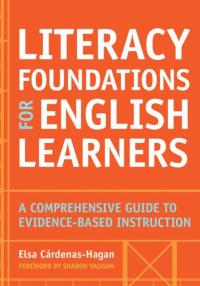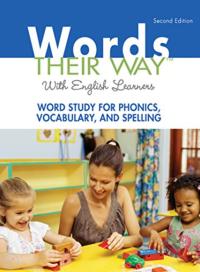Learning to read is a complicated process. If you teach English language learners (ELLs), there are a number of ways you can support their literacy and language development through targeted instruction.
This article highlights ELL instructional strategies based on the five components of reading as outlined in the report by the National Reading Panel (2000). This report is a study of research-based best practices in reading instruction and it focuses on the following five instructional areas:
- phonemic awareness
- phonics,
- vocabulary
- fluency
- comprehension
In addition, this section includes information related to two additional important areas of instruction for ELLs:
- oral language
- role of the home language
What does the research say?
In general, what we know about effective literacy instruction for English speakers holds true for ELLs, but modifications and adjustments may be needed (Goldenberg, 2008). Since the original National Reading Panel did not include ELLs’ literacy development as part of its research review, a subsequent panel reviewed the research related to language learners and released a report authored by principal investigator Dr. Diane August and panel chair Dr. Timothy Shanahan titled Developing Literacy in Second-Language Learners: Report of the National Literacy Panel on Language-Minority Children and Youth.
Within the executive summary of that report, the authors note:
“Instruction that provides substantial coverage in the key components of reading — identified by the National Reading Panel (NICHD, 2000) as phonemic awareness, phonics, fluency, vocabulary, and text comprehension — has clear benefits for language-minority students … However, while approaches that are similar to those used with native-language populations are effective, the research suggests that adjustments to these approaches are needed to have maximum benefit with language-minority students.”
For example, many practices may need modifications or scaffolds which may not be reflected in different reading programs or materials (August, 2018; Goldenberg, 2008), and in some cases, certain strategies may not be appropriate even with adjustments. In addition, the authors note the important role of two areas that were not addressed in the original National Reading Panel: students’ home language and oral language.
Students’ home languages
When working with ELLs, students’ home languages are a powerful tool that educators can use — even if they don’t speak those languages or are working in a classroom with students who speak many languages. In their executive summary, Drs. August and Shanahan write:
“Oral proficiency and literacy in the first language can be used to facilitate literacy development in English.”
And in his Colorín Colorado article (August & Shanahan, 2006; Riches & Genesee, 2006) about the value of students’ home language, Dr. Fred Genesee writes:
Extensive research, again from around the world, has found that children who are learning to read in a second language are able to transfer many skills and knowledge from their first language to facilitate their acquisition of reading skills in the second language. The best evidence of this comes from studies showing that students with strong reading skills in the home language also have strong reading skills in their second language. Much of this work has been done on ELLs in the U.S.
Tapping into students’ home languages (also referred to as a first or native language) as a resource can take different forms:
- Helping students make connections between their language and English in order to identify similarities and differences, such as English/Spanish cognates
- Providing opportunities to use the home language in the classroom for reading, writing, and discussion
- Encouraging students to draw on all of their language skills across languages, which is called translanguaging
- Promoting biliteracy through bilingual or dual-language instruction, which can support students’ future opportunities and family ties (not to mention brain health!), with initiatives such as the Seal of Biliteracy, which has been adopted in many states
It is important to keep in mind that the extent to which a student’s literacy skills from their first language transfer depends on many factors, such as how similar the alphabetic systems between the two languages are and whether they share any connection in their origins, such as two languages that both derive from Latin (Nieser & Cárdenas-Hagan, 2020, p. 65). The students’ levels of literacy in their home language will also have an impact on their literacy development in their new language. Learning more about the languages students speak can help educators target instruction, notice patterns among speakers of the same language, and help students understand the relationship between their language and English.
In her 2018 American Educator article on best practices for ELLs, Dr. Diane August writes,
It is helpful to teach ELLs the same skills as their English-proficient peers — the skills of hearing the individual English sounds or phonemes within words (i.e., phonemic awareness); using the letters and spelling patterns within words to decode the pronunciation (i.e., phonics); reading text aloud with appropriate speed, accuracy, and expression (i.e., oral reading fluency); using strategies to learn new words; thinking about what they are reading (i.e., reading comprehension); and writing with the organization, development, substance, and style appropriate to the task and audience.
You can also provide students and families with access to bilingual books and texts and encourage families to continue using and developing the home language through activities such as rhymes, storytelling, and conversation at home. You will also find specific strategies related to home language throughout the key components below.
Learn more
- The Home Language: An English Language Learner’s Most Valuable Resource (Colorín Colorado)
- Using Cognates with ELLs (Colorín Colorado)
- Translanguaging (WIDA)
Expert voices
Teaching English Learners: What Every Educator Should Know, with Elsa Cárdenas-Hagan, Ed.D.
In this multimedia presentation from our sister site Reading Universe, Dr. Cárdenas-Hagan explains what reading teachers should know about working with English Learners. With a focus on students whose home language is Spanish, Dr. Cárdenas-Hagan discusses cross-language connections and demonstrates how to integrate language development into early-reading lessons. She describes how to build on what students already know to help them learn new words and improve their reading comprehension. With graphics and clips of a student tutoring session interspersed, this timely talk is a powerful professional-development tool for any educator looking to better serve the English Learners in their classroom.
Oral language development
In addition, oral language has a role to play across all reading skills, yet it often does not receive much attention as a critical part of ELLs’ language and literacy development. In their executive summary, Drs. August and Shanahan write:
“Instruction in the key components of reading is necessary — but not sufficient — for teaching language-minority students to read and write proficiently in English. Oral proficiency in English is critical as well — but student performance suggests that it is often overlooked in instruction.”
Oral language supports students’ literacy skills in different ways. For example, students need to be familiar not only with the sounds and letters they are learning but also the words in which they appear in order to support their word recognition and comprehension. Other more global oral language skills, such as facility with English syntax and grammar, and the ability to navigate specific language functions like describing, predicting, and comparing, also contribute to both reading and writing development for ELLs.
In addition, strengthening oral language supports students’ ability to participate in peer groups and their proficiency in speaking and writing using academic language. Students need opportunities to practice applying their emerging oral language skills through partner talk and peer work (scaffolded with supports such as sentence frames), activities such as partner reading, and responding to comprehension questions using academic language.
Dr. Carrie Simkin, the director of our sister site AdLit.org, offers the following suggestions related to oral language:
- Make it a learning target for lesson planning (e.g. be intentional about planning for it).
- Consider how much of the learning time in your classroom is text based vs. discussion. Do students have opportunities to discuss ideas or do they mostly respond in written formats? We want to engage students in lively discussions!
- Consider if students have opportunities to work in pairs as well as small groups and not just respond to teacher-generated questions.
- Have you modeled how to orally respond to questions using the question as a sentence starter? Do you have sentence starters visible for share-outs?
Our strategies related to oral language are also woven throughout the components below.
Learn more
- Oral Language Development and ELLs: Five Challenges and Solutions (Colorín Colorado)
- Video Series: Engaging ELLs in Academic Conversations (Colorín Colorado)
- Meaningful Classroom Talk: Supporting English Learners’ Oral Language Development (Colorín Colorado)
- Comprehension and English Language Learners: 25 Oral Reading Strategies That Cross Proficiency Levels by Michael Opitz and Lindsey Moses
Phonemic awareness and ELLs
Phonemic awareness is an important indicator of how well children will learn to read. Sometimes it is difficult, however, for speakers of a second language to “hear” and say sounds in the language they are learning. If you have had a student who could not master a particular sound in English, the sound may not have been a part of the student’s native language.
In her chapter of Literacy Foundations for English Learners, Dr. Virginia Lovelace-Gonzalez notes that, “Phonological awareness skills can transfer across languages when students have opportunities to build these skills in their native language and English” (2020, p. 53).
For example, there are multiple sounds in English and Spanish that will directly transfer between languages, even if the sounds are associated with different letters (p. 50). Dr. Lovelace-Gonzalez writes, “For ELs, phonemic activities in English can be complicated by having to recognize sounds in English that do not exist in their native language…Instructionally, it is important for teachers to determine some of the similarities and differences between English and the student’s native language to ensure the opportunity to learn” (p. 53).
What is phonemic awareness? The ability to hear and manipulate the different sounds in our language.
Why it matters: Phonemic awareness is the foundation for spelling and word recognition skills.
| Considerations for ELLs | |
|---|---|
| Sound recognition and production |
|
| Strategies for ELLs | |
|---|---|
Learn more about the students’ home languages. |
|
Help students think about the connection between their language and English. |
|
Use familiar vocabulary words for building phonemic awareness. |
|
Model production of the sound. |
|
Help beginning readers learn to identify sounds in short words. |
|
Phonics and ELLs
Phonics instruction aims to help new readers understand that there are systematic and predictable relationships between written letters and spoken sounds. Students benefit from learning and practicing sounds and symbols, including blended combinations. ELLs often show many strengths in mastering early phonics skills but it’s important to remember that decoding while reading and correctly spelling words does not ensure good comprehension.
That’s why it’s important to ensure that ELLs are familiar with the words they are learning to decode in order to support their comprehension. The authors of Words Their Way with English Learners write, “English learners need structured opportunities to learn many new words to add to their repertoires so that these words can become the material of their literacy learning” (2011, p. 79).
What is phonics? The relationship between a sound and its corresponding written letter.
Why it matters: Reading development is dependent on the understanding that letters and letter patterns represent the sounds of spoken language.
| Considerations for ELLs | |
|---|---|
| Literacy skills in native language |
|
| Unfamiliar vocabulary words |
|
| Strategies for ELLs | |
|---|---|
| Help students make a connection between their first language and English. |
|
| Teach phonics in a systematic and explicit way. |
|
| Use a word study approach. |
|
| Look for opportunities to reinforce phonics in context. | Using literature and content material, you can introduce and reinforce:
|
| Use hands-on activities to help teach letter-sound relationships. |
|
| Have students write for sound. |
|
Helping English Learners with Short ‘i’ and Short ‘e’
While helping her multilingual students hear and produce the subtle difference between the short ‘i’ and short ‘e’ sounds, third grade teacher Estella Escajeda, of Loma Linda Elementary School in Anthony, New Mexico, also provides them with a bridge from Spanish to English by talking explicitly about the connections between the two languages. (From our sister project, Reading Universe )
Learn more
Vocabulary and ELLs
Vocabulary plays an important part in learning to read, as well as in understanding what is read.
As students learn to read more advanced texts, they must learn the meaning of new words that are not part of their oral vocabulary. For ELLs, vocabulary development is especially important as students’ develop academic language — in all subjects and activities! There are numerous ways to support explicit vocabulary instruction, which is essential for developing students’ vocabulary knowledge. Dr. Coleen D. Carlson writes,
For EL students, drawing attention to unknown words during the initial presentation of the text, providing appropriate levels of definitions (e.g., providing English labels for words for which concepts and labels in one’s native language are understood, quick definitions or demonstrations for simple words) and tying to background knowledge is critical. No amount of simply reading and rereading words will produce knowledge of unknown vocabulary. (2020, p. 97)
What is vocabulary? Recognizing and understanding words in relation to the context of the reading passage.
Why it matters: Understanding vocabulary words is a key step in reading comprehension. The more words a student knows, the better he or she will understand the text.
| Considerations for ELLs | |
|---|---|
| Learning new vocabulary in English |
|
| Strategies for ELLs | |
|---|---|
| Draw upon students’ home languages. | You can draw upon students’ home languages to build vocabulary by:
|
| Pre-teach vocabulary. | It is important to give students as much exposure and experience with new vocabulary words as possible before asking students to use them in a lesson or activity. Select words that will support the reader’s understanding of the story or text, as well as for other phrases and connectors that affect comprehension (even though, except, etc.). You can pre-teach vocabulary by using English as a second language (ESL) methods such as:
|
| Focus on cognates. |
|
| Give students an opportunity to practice using new words. | As the teacher, you can explicitly teach word meanings to improve comprehension. However, to know a word means knowing it in all of the following dimensions:
Ensure students understand a new word by asking them to produce it themselves either orally or in writing. I taught a summer school unit on habitats and healthy environments, and every student had to learn the phrase, “Reduce, reuse, recycle.” Over the course of four weeks I gave students many opportunities to use those words to describe what we were doing: “We are reusing the grocery bag,” or “We reused the scratch paper.” |
| Build students’ academic vocabulary. | You can increase students’ academic vocabulary by teaching common structures and terms used in a specific content area. For example, sentence frames are a great way to get students familiar with these structures and can be used in writing and speaking: You can learn more strategies in this related article.
|
Fluency and ELLs
Fluency is a tricky area when it comes to ELL reading instruction. For native English speakers, fluency and reading comprehension often share a strong correlation because fluent readers recognize words and comprehend at the same time. This is not always the case for ELLs.
Many ELLs can be deceptively fast and accurate in their reading because they are good readers in their primary language and have strong decoding skills. Yet they may demonstrate little understanding of the text, and hearing the text out loud may not necessarily provide a step towards comprehension as it is likely to do for native speakers. One important factor in the connection between fluency and comprehension is ELLs’ oral language skills, which Dr. Carlson describes as “an important foundation that supports the role of fluency as a bridge to comprehension” (p. 93).
What is fluency? The ability to read a text accurately and quickly.
Why it matters: Fluency is important because it provides a bridge between word recognition and comprehension.
| Challenges for ELLs | |
|---|---|
| Inaccurate indicator of ELLs’ comprehension | It is not unusual for an ELL student to read a passage beautifully and then not be able answer more than a couple of comprehension questions correctly. Decoding skills (sounding out words) and comprehending the text are two different skills. |
| Limited benefit from hearing texts read aloud | Native speakers who are not strong decoders can often comprehend text that is read to them better than text that they read themselves. That’s because when someone else is doing the reading, they can focus on meaning without having to struggle to get the words off the page. With ELLs, however, comprehension problems tend to be associated with limited vocabulary and limited background knowledge. Thus, listening to text read by someone else won’t enhance comprehension. |
| Strategies for ELLs | |
|---|---|
| Balance fluency and comprehension. |
|
| Give students a chance to practice reading out loud. |
|
| Allow students to practice reading along with taped text. |
|
Comprehension and ELLs
Comprehension is the understanding and interpretation of what is read. To be able to accurately understand written material, children need to be able to 1) decode what they read; 2) make connections between what they read and what they already know; and 3) think deeply about what they have read. Comprehension can be the most difficult skill to master, however, and can elude students who have mastered word-level skills. According to the executive summary of the National Literacy Panel on Language-Minority Children and Youth,
An important finding that emerges from the research is that word-level skills in literacy — such as decoding, word recognition and spelling — are often taught well enough to allow language-minority students to attain levels of performance equal to those of native English speakers. However, this is not the case for text-level skills — reading comprehension and writing. (p. 4)
ELLs at all levels of English proficiency, and literacy development, will benefit from explicit instruction in comprehension skills along with other skills because improved comprehension will not only help them in language arts and ESL classes — it will help them in content-area classes and in daily activities. It will also improve the chances of their interest in reading for pleasure.
What is comprehension? Understanding the meaning of the text.
Why it matters: Comprehension is the reason for reading. Readers who have strong comprehension are able to draw conclusions about what they read.
| Considerations for ELLs | |
|---|---|
| Reading for meaning | ELLs who struggle with comprehension may read more slowly, have a hard time following a text or story, have a hard time picking out important events, and feel frustrated. They may also have problems mastering new concepts in their content-area classes or completing assignments and assessments because they cannot comprehend the texts and tests for these subjects. |
| Strategies for ELLs | |
|---|---|
| Use students’ home languages for support. |
|
| Consider the role of background knowledge. |
|
| Connect content to students’ background knowledge. |
|
| Check comprehension frequently. | As students read, ask them open-ended questions about what they are reading, and informally test students’ ability to sequence material from sentences or a story by printing sentences from a section of the story on paper strips, mixing the strips or word order, and having students put them in order. |
| Use questions after reading. | After the ELLs and/or whole class have completed the reading, you can test their comprehension with carefully crafted questions, taking care to use simple sentences and key vocabulary from the text they just read. These questions can be at the:
|
Learn more from Colorín Colorado
Interactive reading of a story
First-grade teacher Albuquerque teacher Ali Nava leads her students through an interactive reading of Burro’s Tortillas, a Southwestern adaptation of “The Little Red Hen.”
Featured video: whole-school approaches
ELLs Belong to All of Us: The Role of ESOL Specialists in Collaboration
This video showcases a 5th-grade team planning a science lesson about the difference between vascular and non-vascular plants. ESOL specialist Katy Padilla plays a key role in advocating for ELLs throughout the lesson planning process and sharing her strategies for engaging and supporting students.
Making Dual-Language Immersion Work
This video provides an introduction to Claremont Immersion School’s dual language model and shows how teachers collaborating to develop a language arts language in English and Spanish.
Assessment for ELLs
Learn how third-grade teacher Samantha Kirch uses informal assessment in her classroom to better evaluate ELLs and their progress.
More resources on teaching reading to ELLs
English Language Learners
Vocabulary Development with ELLs
Background Knowledge
Connect Students’ Background Knowledge to Content in the ELL Classroom
English Language Learners
Increasing Academic Language Knowledge for English Language Learner Success
Research Report
Teaching English Language Learners: What the Research Does — and Does Not — Say
2008
Browse our English language learners resource library
Learn more about the most effective ways to teach ELL students, how to create a welcoming classroom, and ways to promote family involvement. Visit our English language learners section
Books about teaching ELLs

Literacy Foundations for English Learners

Words Their Way with English Learners: Word Study for Phonics, Vocabulary, and Spelling (2nd Edition)

Dual Language Instruction from A to Z: Practical Guidance for Teachers and Administrators
Learn more at Colorín Colorado
Reading 101 for English Language Learners was created by ELL experts Kristina Robertson and Lydia Breiseth and originally published on Colorín Colorado. It is excerpted from Reading Instruction in Grades 1-3 for ELLs (with references), part of the in-depth resource, Literacy Instruction for ELLs on Colorín Colorado. We invite you to explore the wealth of resources on the site!








